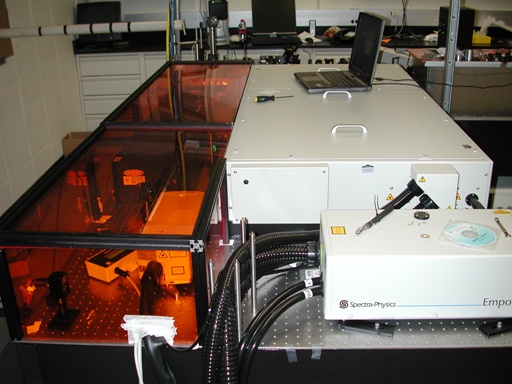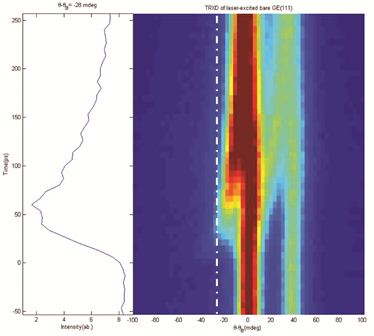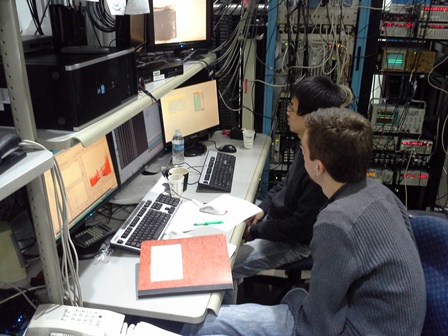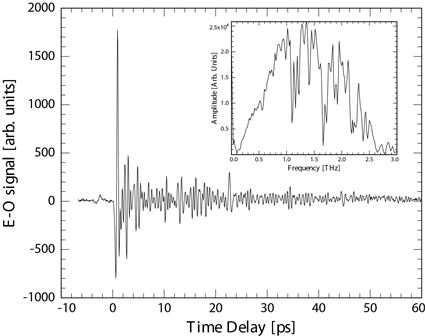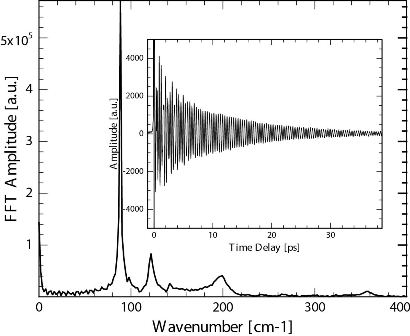Research: Difference between revisions
| (11 intermediate revisions by 2 users not shown) | |||
| Line 6: | Line 6: | ||
== Laser system == | == Laser system == | ||
The backbone of any ultrafast spectroscopy lab is the laser source. The DeCamp lab has a 1kHz Spectra-Physics Spitfire XP amplifier seeded by a KMLabs Oscillator. The laser generates 3mJ, sub-40fs laser pulses for ultrafast spectroscopy. The laser output has been upgraded to produce 5+mJ at 1kHz by the construction of a home built, | The backbone of any ultrafast spectroscopy lab is the laser source. The DeCamp lab has a 1kHz Spectra-Physics Spitfire XP amplifier seeded by a KMLabs Oscillator. The laser generates 3mJ, sub-40fs laser pulses for ultrafast spectroscopy. The laser output has been upgraded to produce 5+mJ at 1kHz by the construction of a home built, LN<math>_2</math> cooled multipass power amplifier. Using modest focusing, this laser is able to generate optical fields greater than <math>10^{17}</math>W/cm<math>^2</math>. | ||
[[File:Spitfire.jpg]] | [[File:Spitfire.jpg]] | ||
== Time-resolved X-ray diffraction == | == Time-resolved X-ray diffraction == | ||
We are currently utilizing a sub-picosecond x-ray source based upon generation of a dense plasma via intense (>10^15 W/ | We are currently utilizing a sub-picosecond x-ray source based upon generation of a dense plasma via intense (><math>10^{15}</math>W/cm<math>^2</math>) laser excitation of solid targets, specifically a copper wire. In conjunction with stroboscopic pump-probe techniques, we are able to measure structural changes in crystals as small as <math>10^{-13}</math>m with picosecond time resolution. The figure below demonstrates the capabilities of the system by measuring the sub-picosecond optical excitation of a Germanium (111) crystal. The generation of x-ray diffraction sidebands indicate the presence of a transient acoustic wave inside the bulk crystal. | ||
[[File:TRXD_Ge.jpg]] | [[File:TRXD_Ge.jpg]] | ||
Current experiments utilizing this x-ray source for the study of the ultrafast lattice dynamics of nanostructured systems. | Current experiments utilizing this x-ray source for the study of the ultrafast lattice dynamics of nanostructured systems. | ||
In addition we have started to perform time-resolved x-ray experiments at the Advanced Photon Source. These experiments look to efficiently slice 100ps x-ray pulses using ultrafast acoustic pulses. | |||
[[File:APS_data.jpg]] | |||
== Time-Domain Terahertz spectroscopy == | == Time-Domain Terahertz spectroscopy == | ||
THz radiation is the wavelength range of .020-1mm and can have pulse lengths as fast as 30fs. While these wavelengths are relatively long, it is the spectral region of low frequency molecular vibrations and rotations, making this a useful range for molecular spectroscopy. | THz radiation is the wavelength range of .020-1mm and can have pulse lengths as fast as 30fs. While these wavelengths are relatively long, it is the spectral region of low frequency molecular vibrations and rotations, making this a useful range for molecular spectroscopy. However, as the photon energy exceeding small, traditional direct detection methods are impossible. To detect the THz radiation, we utilize a time-domain THz spectrometer (TDTS), whereby the THz field directly modifies the optical polarization in a birefringent medium. By detecting the change in optical polarization, we can directly map the electric field of the THz radiation in the time-domain. In the figure below, we show a typical time-domain signal from the free-space electro-optic sampling spectrometer. A simple numerical Fourier transform of the electric field reveals the spectral content of the pulse. In this example we see distinct absorption lines associated with water vapor in the laboratory. Currently we are using TDTS to measure vibrational dynamics in molecules as well as electron dynamics in solid-state devices. | ||
[[File:FSEOS_fft.jpg]] | |||
In addition to THz spectroscopy, we are currently trying to modify standard TDTS techniques to build an upconversion THz spectrometer. This device uses the THz field to produce spectral sidebands on a narrow band optical field, which can then be directly detected using optical spectrometers. | |||
== Time-Domain Optical spectroscopy == | == Time-Domain Optical spectroscopy == | ||
We are also using standard optical pump-probe spectroscopy to measure the vibrational dynamics in a variety of systems, ranging from phonon spectroscopy in single crystals to the vibrational dynamics in metallic nanoparticles. For example, the data below shows the vibrational dynamics of a gold nanoparticle in solution as well as the optical phonon dynamics of the crystal Bismuth Germanate | |||
[[File:540nmscan.jpg]] | |||
[[File:BGO2_fft.jpg]] | |||
Latest revision as of 18:33, 5 April 2013
The DeCamp lab uses ultrafast radiation to study the sub-picosecond dynamics of complex systems. This ranges from the structural dynamics of crystalline systems to molecular dynamics in solution. The DeCamp Lab is developing several time-domain spectroscopic tools to fulfill these goals, including time-resolved x-ray scattering, time-domain THz spectroscopy, and time-domain optical spectroscopy.
Laser system
The backbone of any ultrafast spectroscopy lab is the laser source. The DeCamp lab has a 1kHz Spectra-Physics Spitfire XP amplifier seeded by a KMLabs Oscillator. The laser generates 3mJ, sub-40fs laser pulses for ultrafast spectroscopy. The laser output has been upgraded to produce 5+mJ at 1kHz by the construction of a home built, LN cooled multipass power amplifier. Using modest focusing, this laser is able to generate optical fields greater than W/cm.
Time-resolved X-ray diffraction
We are currently utilizing a sub-picosecond x-ray source based upon generation of a dense plasma via intense (>W/cm) laser excitation of solid targets, specifically a copper wire. In conjunction with stroboscopic pump-probe techniques, we are able to measure structural changes in crystals as small as m with picosecond time resolution. The figure below demonstrates the capabilities of the system by measuring the sub-picosecond optical excitation of a Germanium (111) crystal. The generation of x-ray diffraction sidebands indicate the presence of a transient acoustic wave inside the bulk crystal.
Current experiments utilizing this x-ray source for the study of the ultrafast lattice dynamics of nanostructured systems.
In addition we have started to perform time-resolved x-ray experiments at the Advanced Photon Source. These experiments look to efficiently slice 100ps x-ray pulses using ultrafast acoustic pulses.
Time-Domain Terahertz spectroscopy
THz radiation is the wavelength range of .020-1mm and can have pulse lengths as fast as 30fs. While these wavelengths are relatively long, it is the spectral region of low frequency molecular vibrations and rotations, making this a useful range for molecular spectroscopy. However, as the photon energy exceeding small, traditional direct detection methods are impossible. To detect the THz radiation, we utilize a time-domain THz spectrometer (TDTS), whereby the THz field directly modifies the optical polarization in a birefringent medium. By detecting the change in optical polarization, we can directly map the electric field of the THz radiation in the time-domain. In the figure below, we show a typical time-domain signal from the free-space electro-optic sampling spectrometer. A simple numerical Fourier transform of the electric field reveals the spectral content of the pulse. In this example we see distinct absorption lines associated with water vapor in the laboratory. Currently we are using TDTS to measure vibrational dynamics in molecules as well as electron dynamics in solid-state devices.
In addition to THz spectroscopy, we are currently trying to modify standard TDTS techniques to build an upconversion THz spectrometer. This device uses the THz field to produce spectral sidebands on a narrow band optical field, which can then be directly detected using optical spectrometers.
Time-Domain Optical spectroscopy
We are also using standard optical pump-probe spectroscopy to measure the vibrational dynamics in a variety of systems, ranging from phonon spectroscopy in single crystals to the vibrational dynamics in metallic nanoparticles. For example, the data below shows the vibrational dynamics of a gold nanoparticle in solution as well as the optical phonon dynamics of the crystal Bismuth Germanate




